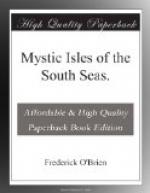It was the holiday season, the New Year at hand, and, moreover, there was added cause for rejoicing in the safety of the Saint Michel, a French-owned inter-island steamship which had been missing six weeks. She had left one of the Paumotu atolls and failed to reach her next port, thirty miles away. Rumor had sent her to the bottom. She was a crank vessel, with a perpetual list, and a roll of twenty-five degrees in the quietest sea; the dread of all compelled by affairs to take passage on her.
“She’s sunk; rolled over too much, and turned turtle,” was the verdict at the Cercle Bougainville. Her agents had sent the Cholita, a small power schooner, to go over the Saint Michel’s course, and find trace of her, if possible. Imagine the excitement along the waterfront when, almost coincident with the sighting of the Noa-Noa, the Saint Michel appeared, pulled by the Cholita. Familiar faces of passengers appeared on her deck as she made fast to the quay, holding cigarettes as if they had waked up after a night in their own beds. The Cholita had found the Saint Michel at the Marquesas Islands, whither she had drifted after losing her rudder on a rock. After a month lying inert at the Marquesas, the Cholita had taken hold and dragged the crippled Saint back to Papeete.
The joy and surprise of the families and friends of the passengers and the crew must have the vent usual here, and what with the Noa-Noa’s crew of amateur sailors, firemen, and yachtsman, and six licensed captains, taking the places of the strikers, the town was filled with pleasure-seekers. A high mass of thanksgiving at the cathedral was followed by a day of explanations, anathemas upon the owners of the Saint Michel, and the striking labor-unions, and of music, dancing, and toasts.
New Year’s eve, two picture shows, hulas, and the festivities of the wedding of Cowan, the prize-fighter, brought in a throng from the districts to add to the Papeete population and the voyagers.
The streets were a blaze of colored gowns and flower-crowned girls and women. The quays were lined with singing and playing country folk. Small boats and canoes were arriving every few minutes during the afternoon with natives who preferred the water route to the Broom Road. Cowan was a favorite boxer, and shortly to face the noted Christchurch Kid, of Christchurch, New Zealand, whose fist was described on the bill-boards as “a rock thrown by a mighty slinger.” Cowan, a half-Polynesian, was beloved for his island blood, and was marrying into a Tahitian family of note and means. The nuptials at the church were preceded by a triumphal procession of the bride and groom in an automobile, with a score of other cars following, the entire party gorgeously adorned with wreaths,—hei in Tahitian,—and the vehicles lavishly decorated with sugar-cane and bamboo tassels. The band of the cinema led the entourage, and played a free choice of appropriate music, “Lohengrin” before the governor’s palace, and “There’ll be a Hot Time in the Old Town To-night” as they passed Lovaina’s. The company sang lustily, and toasts to the embracing couple were drunk generously from spouting champagne-bottles as the cortege circled the principal streets.




